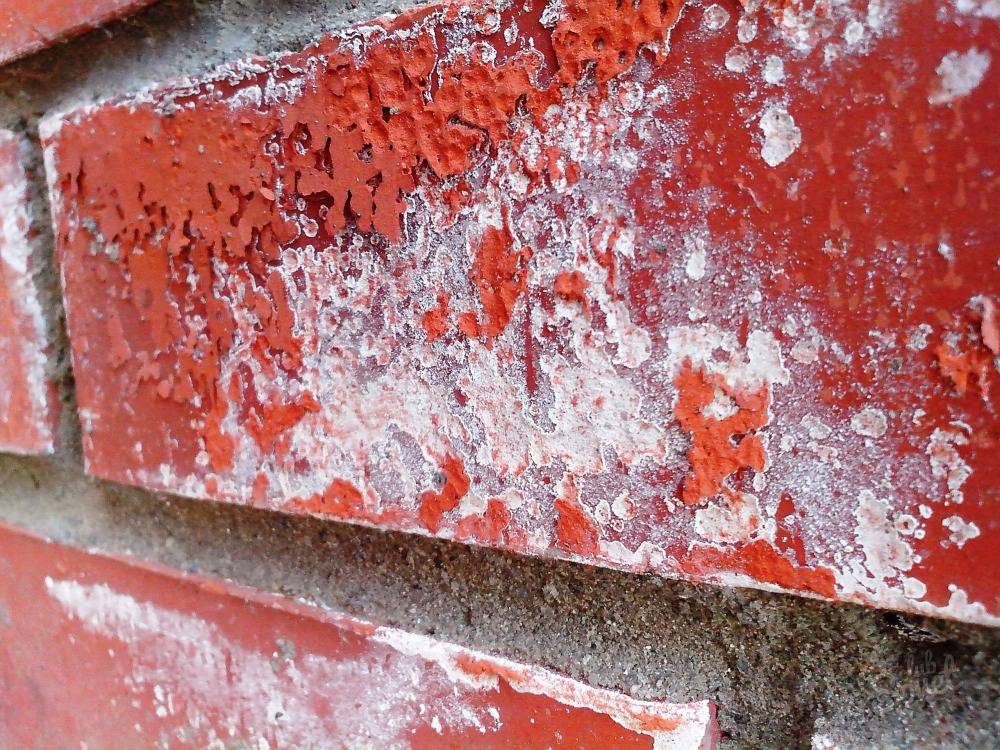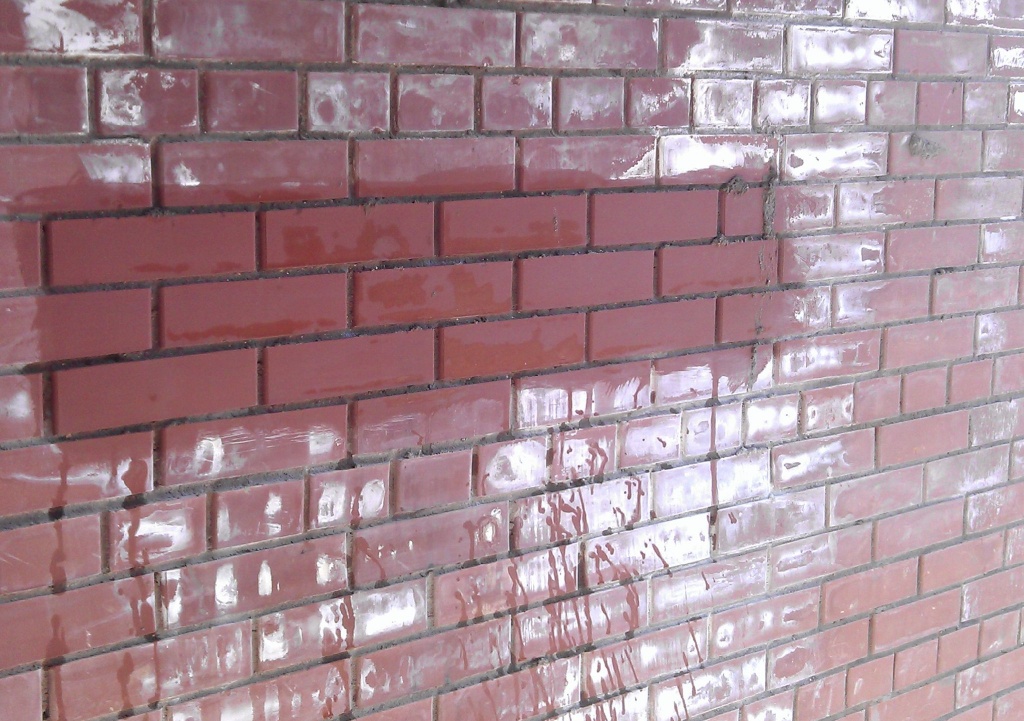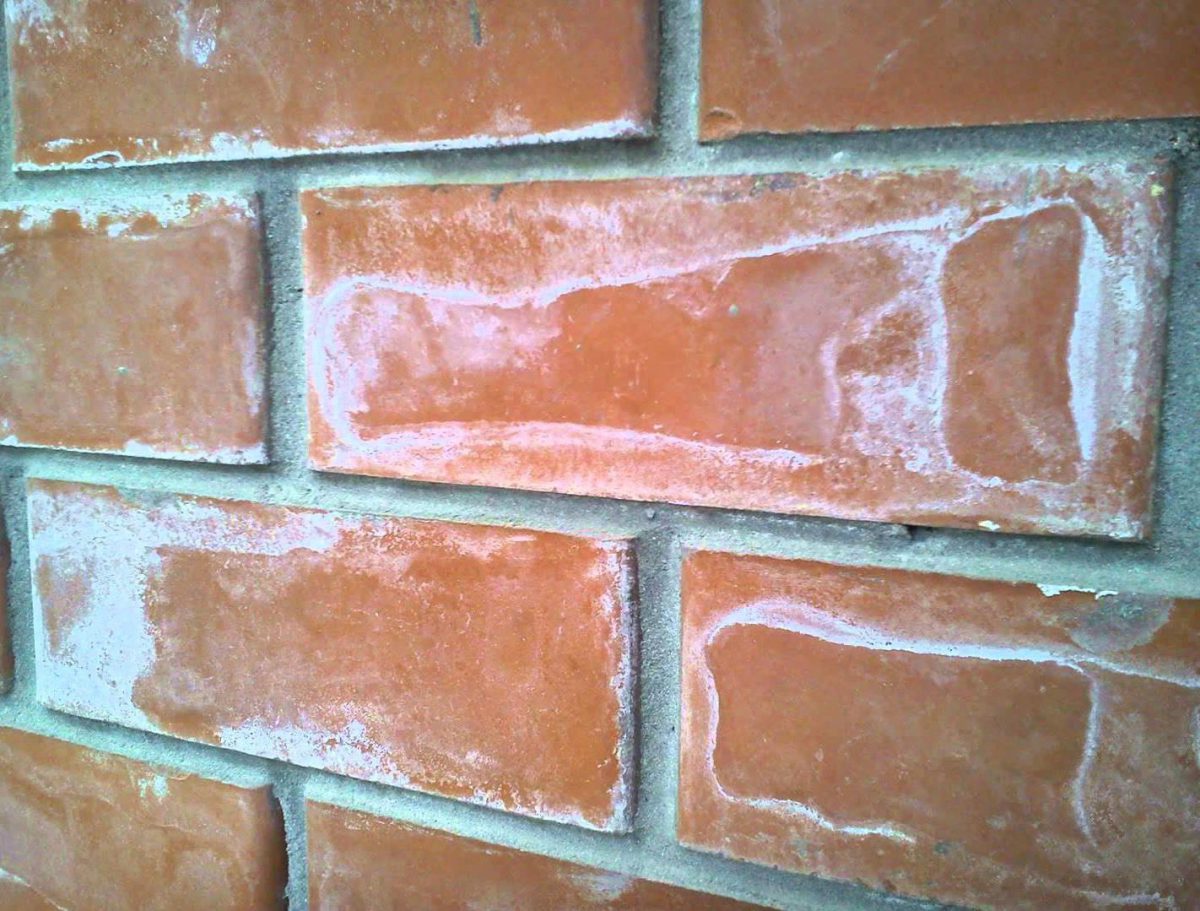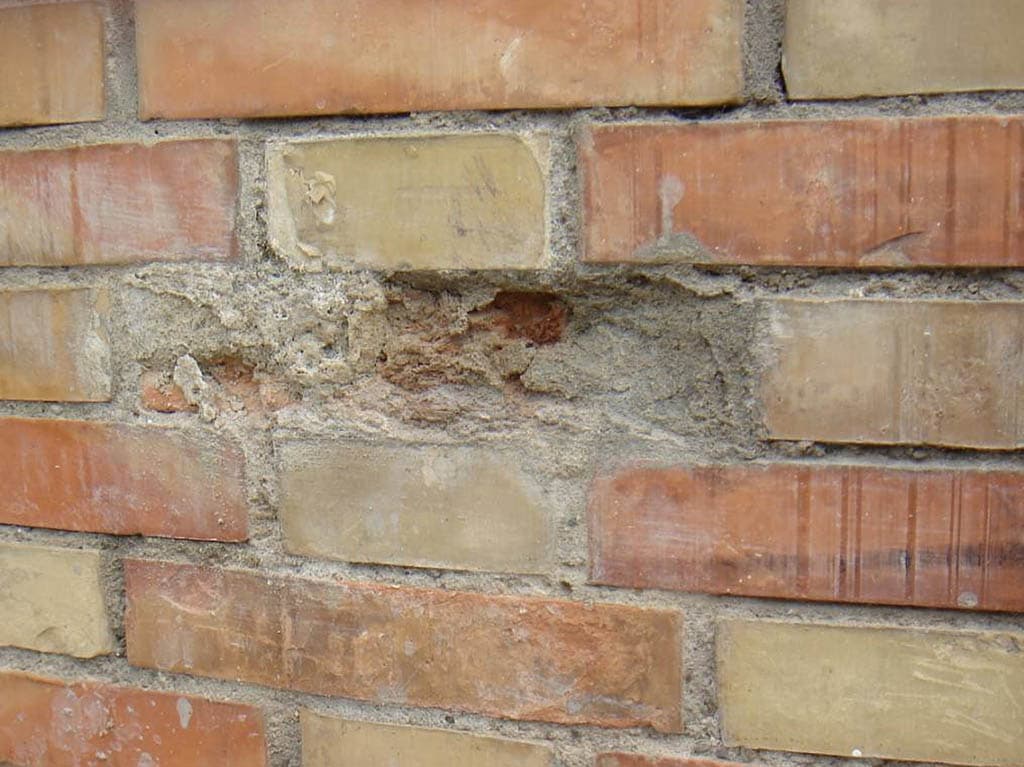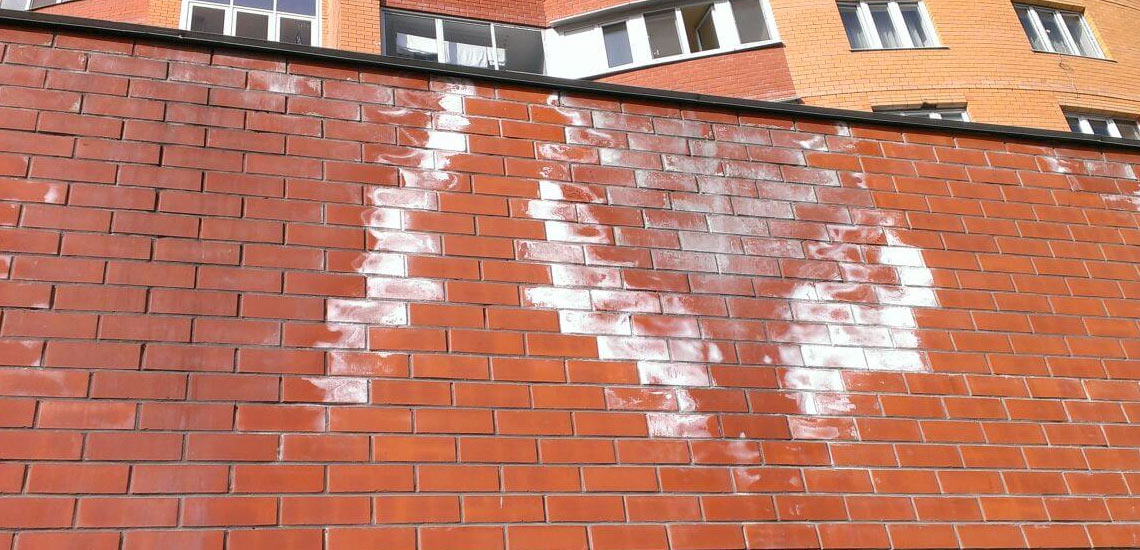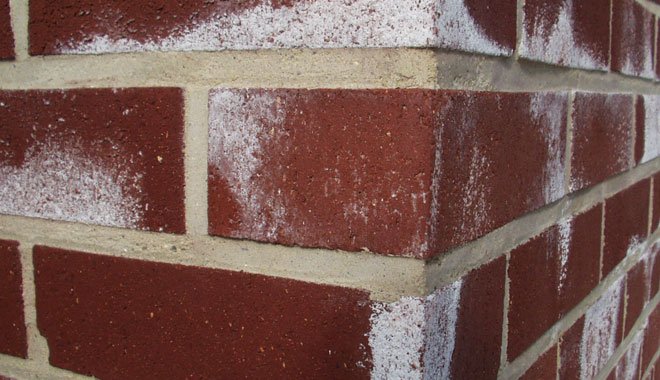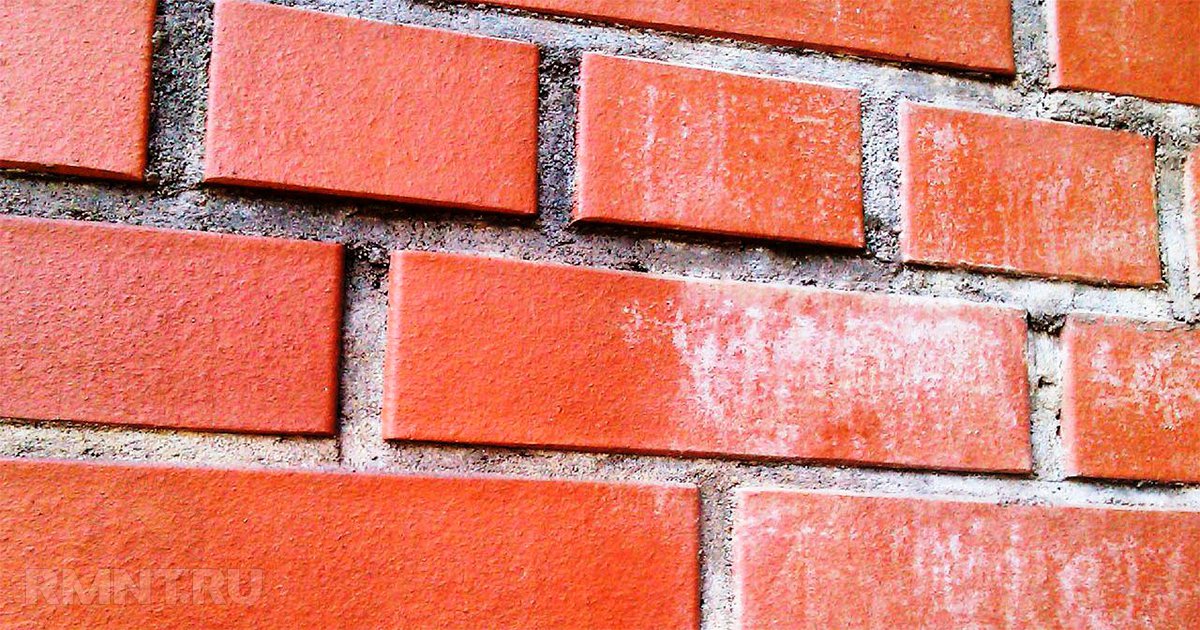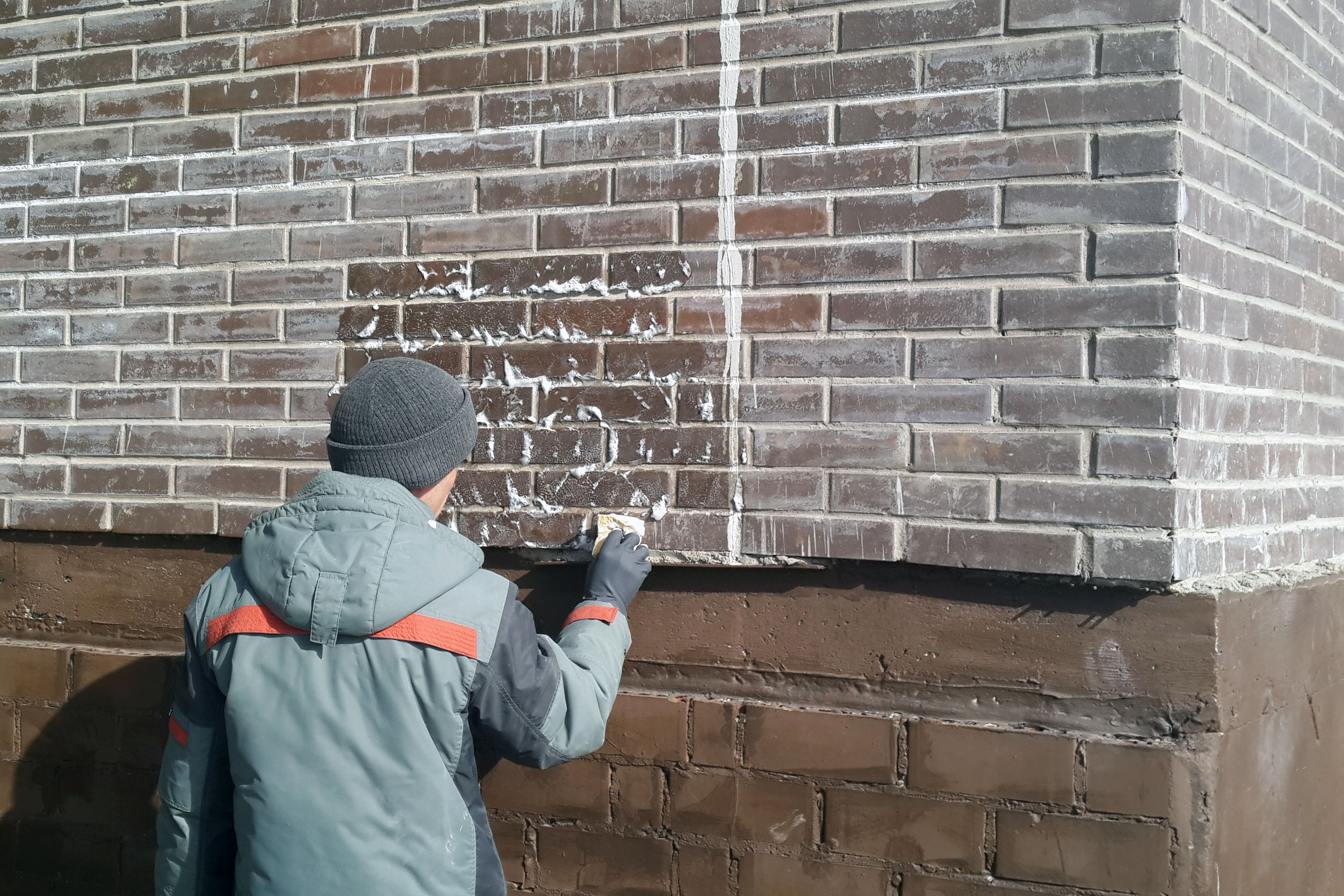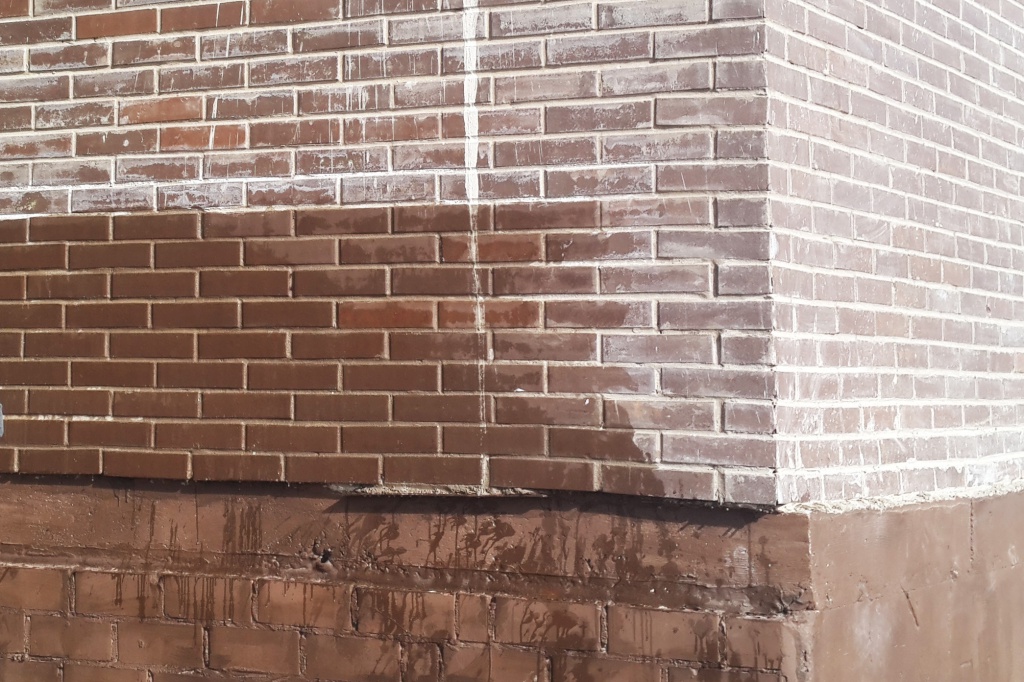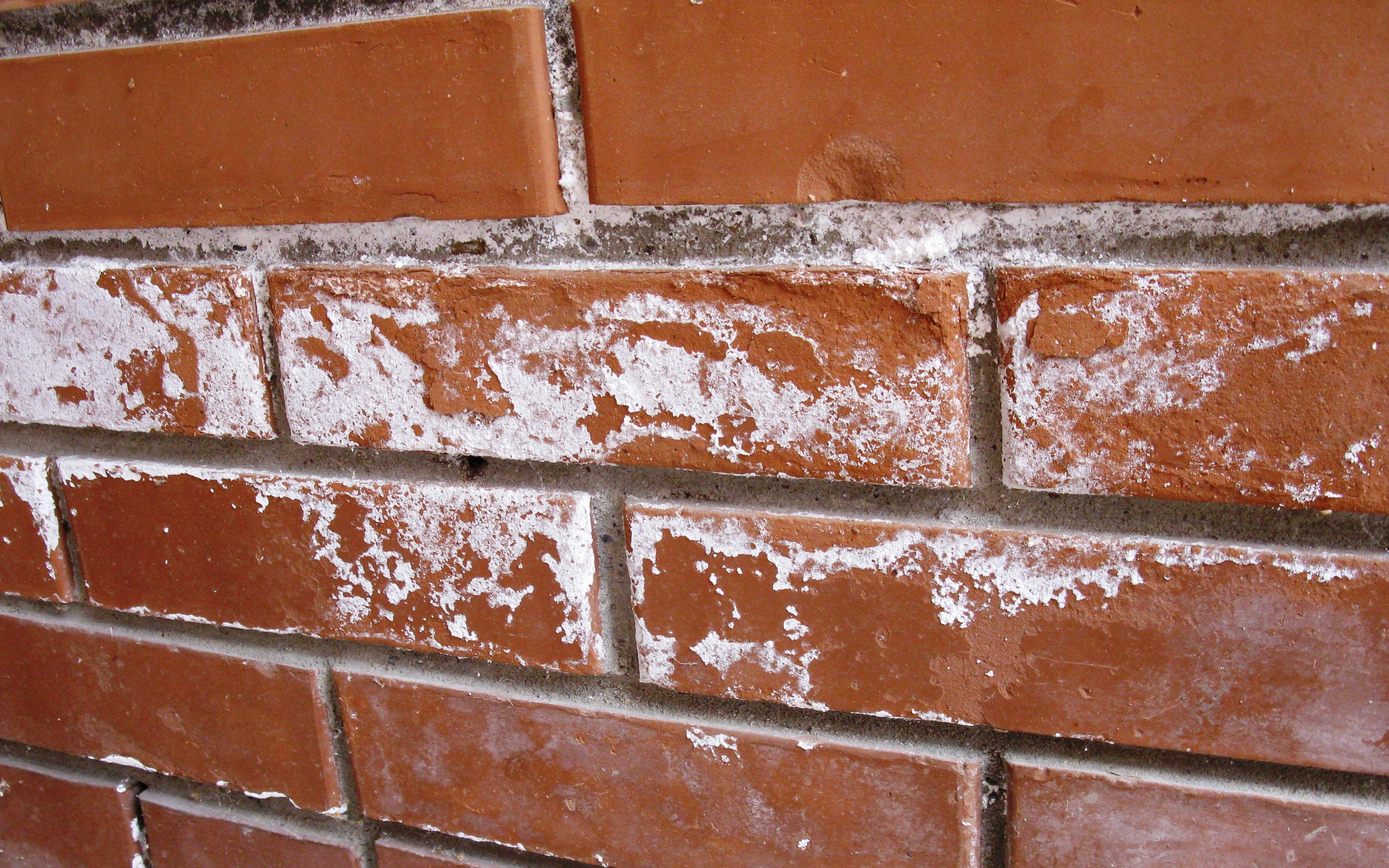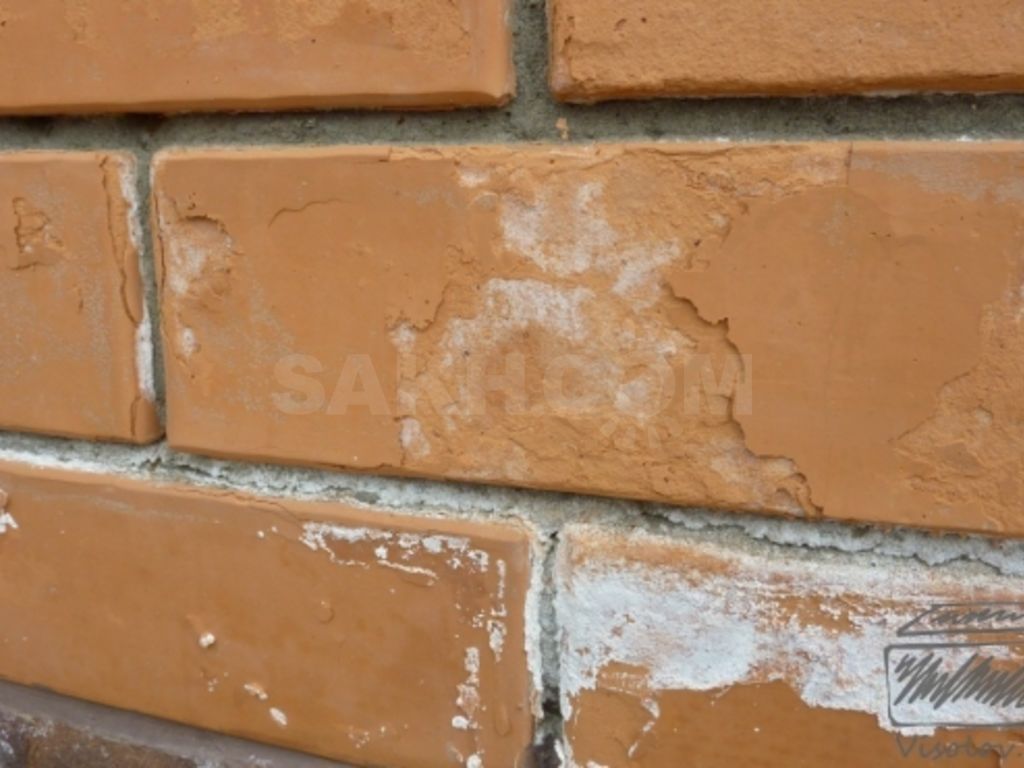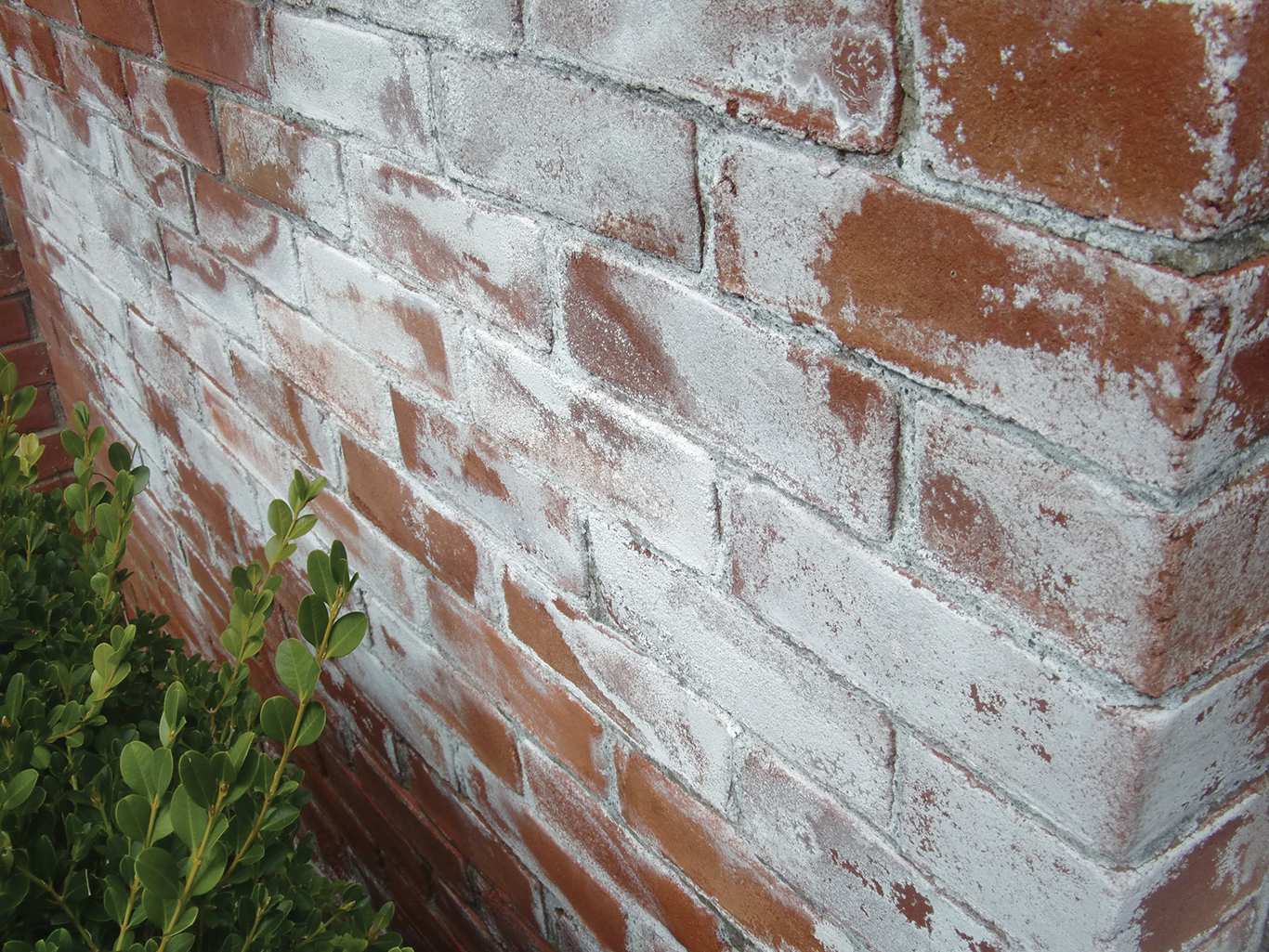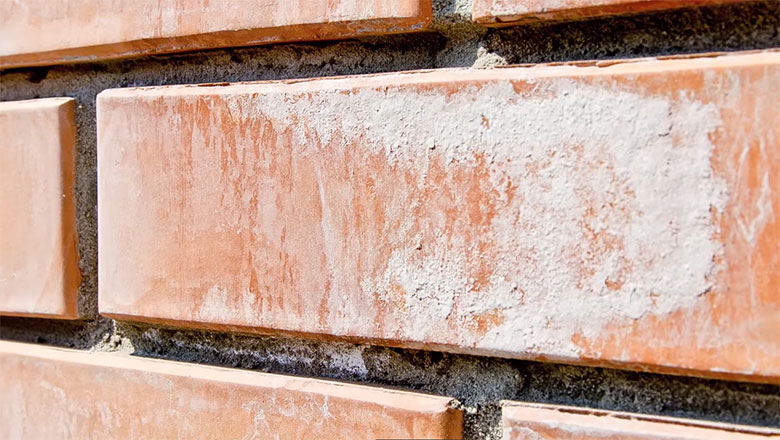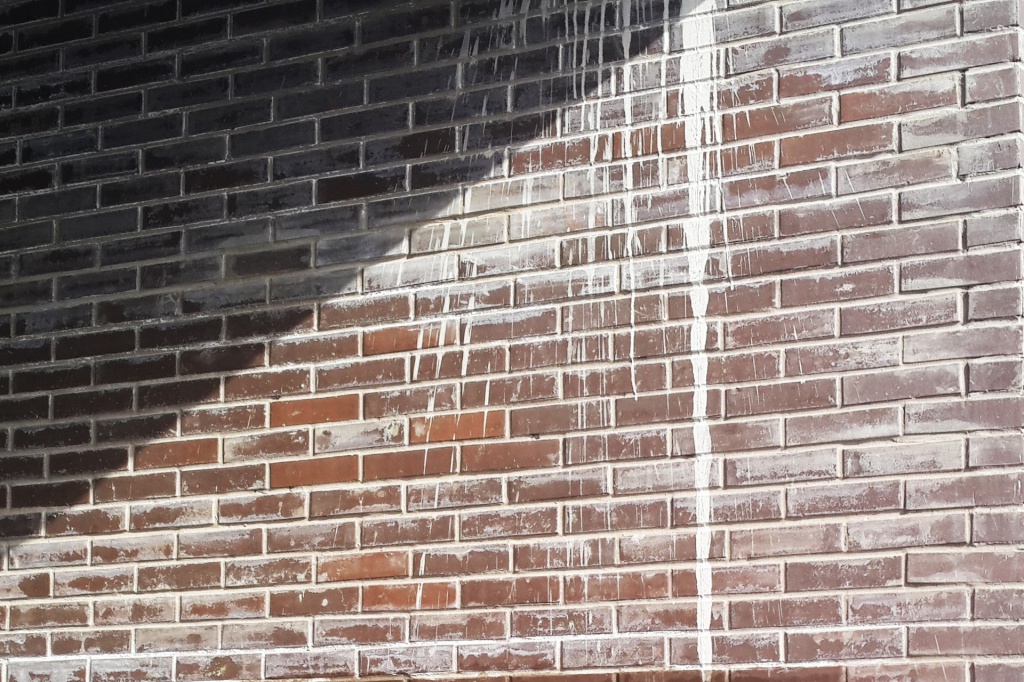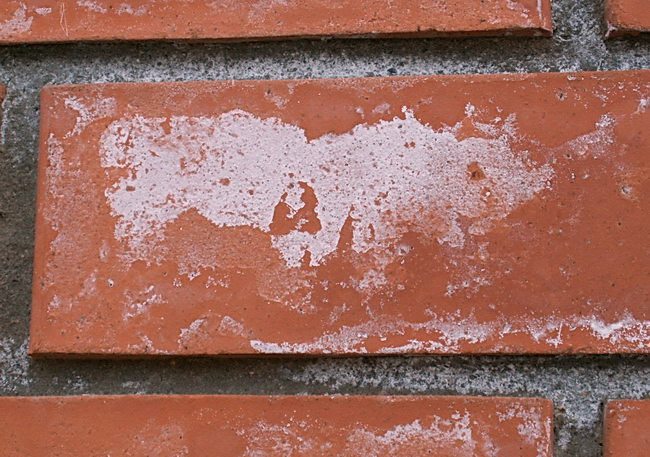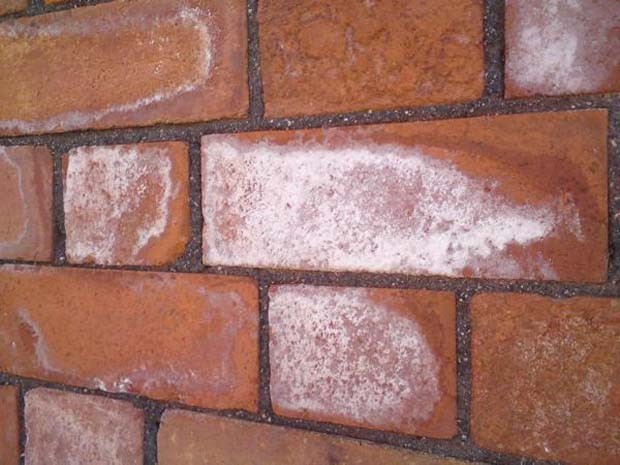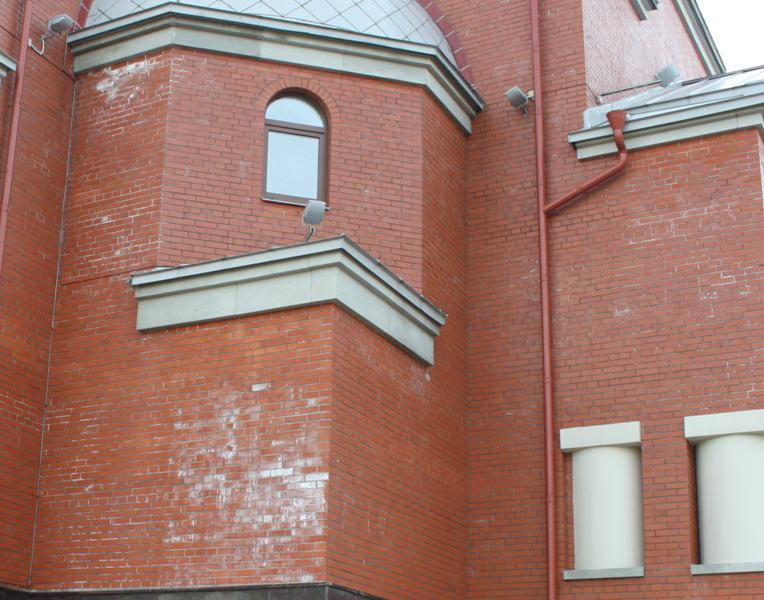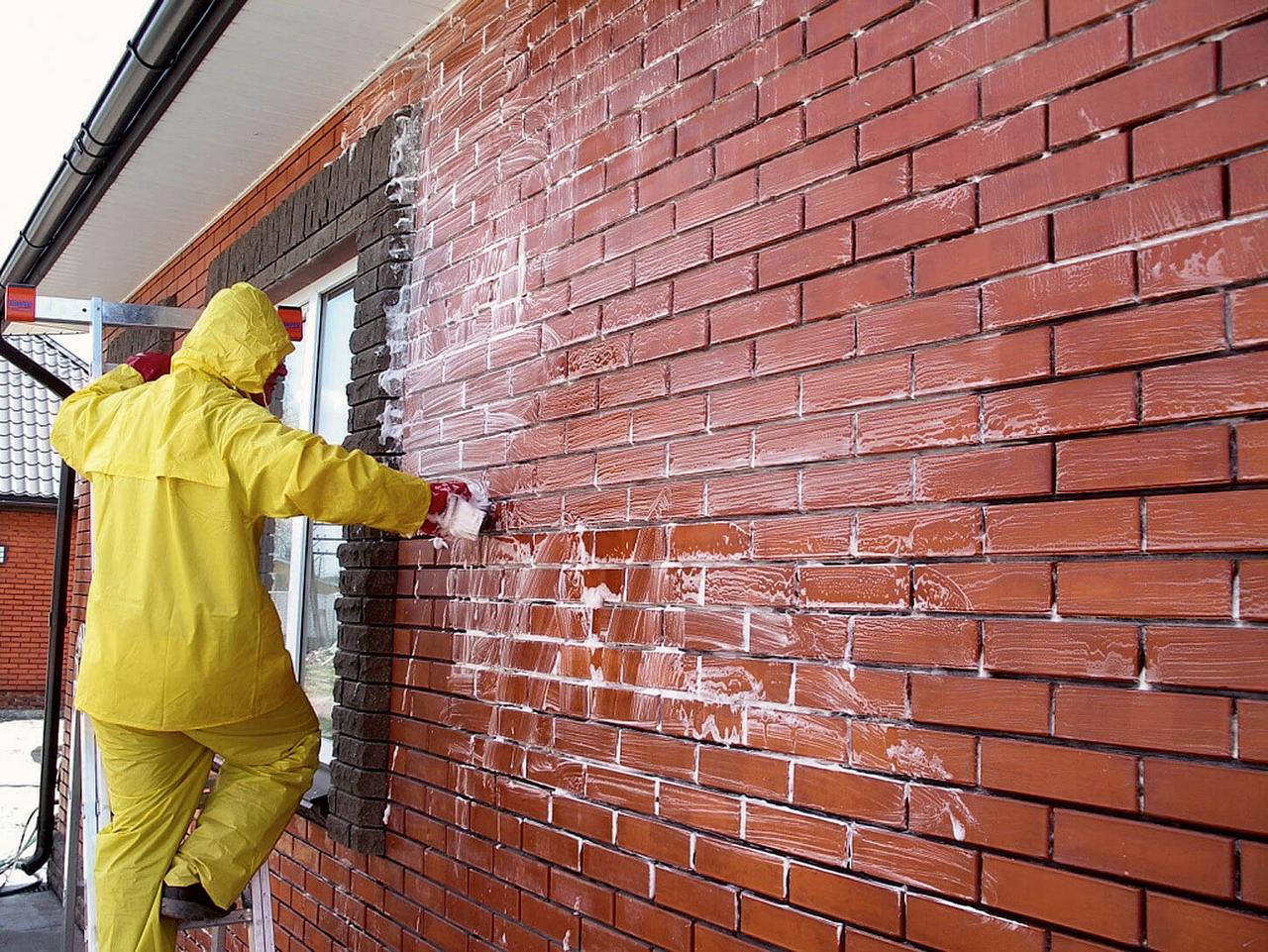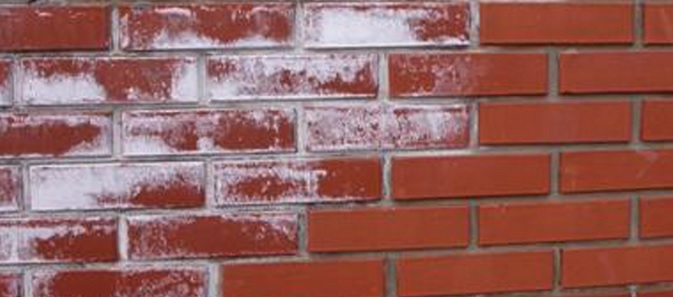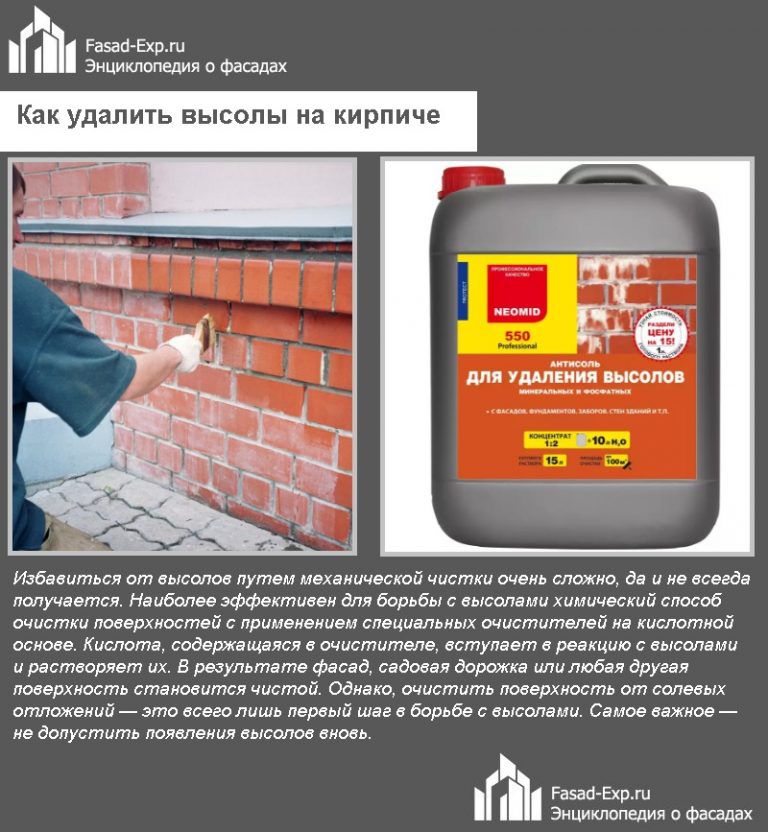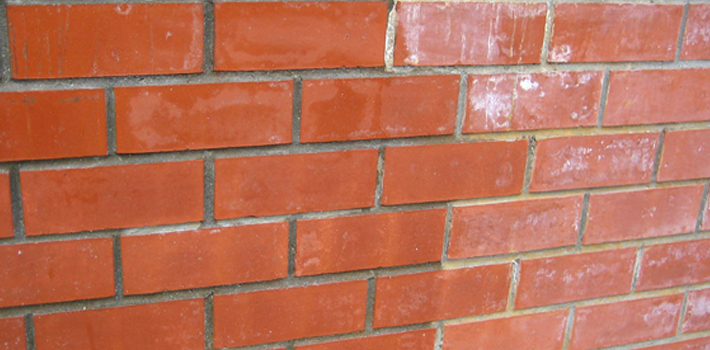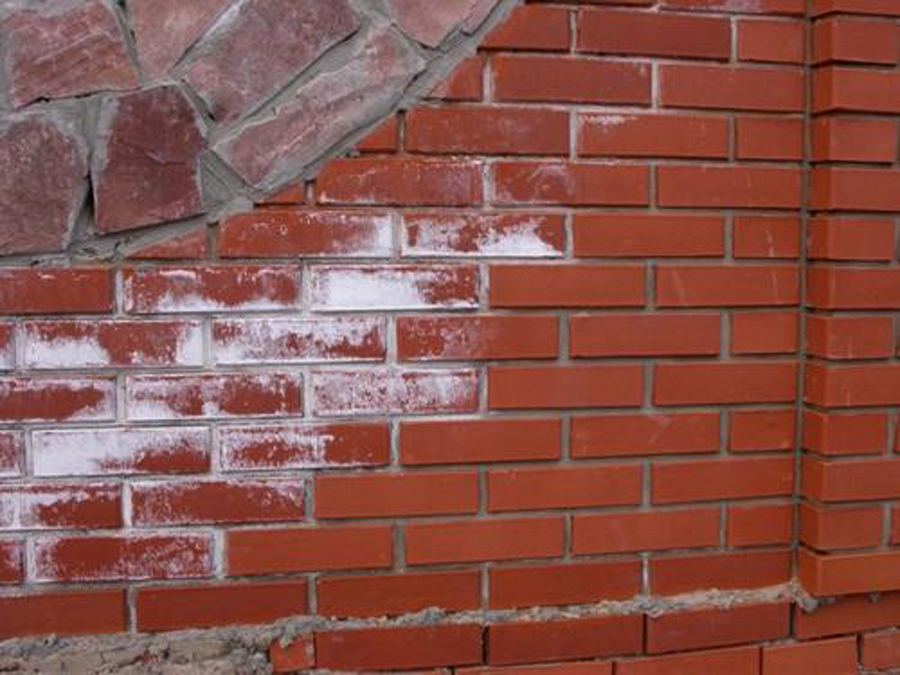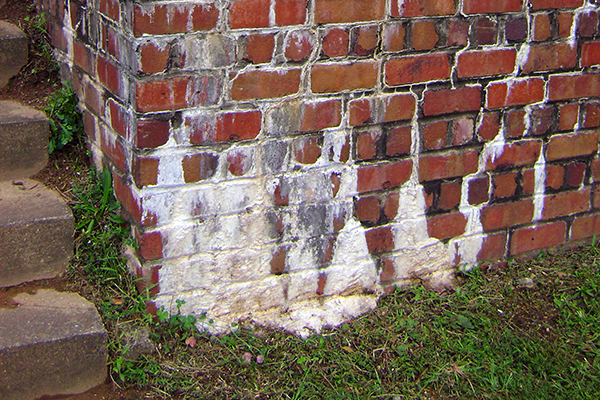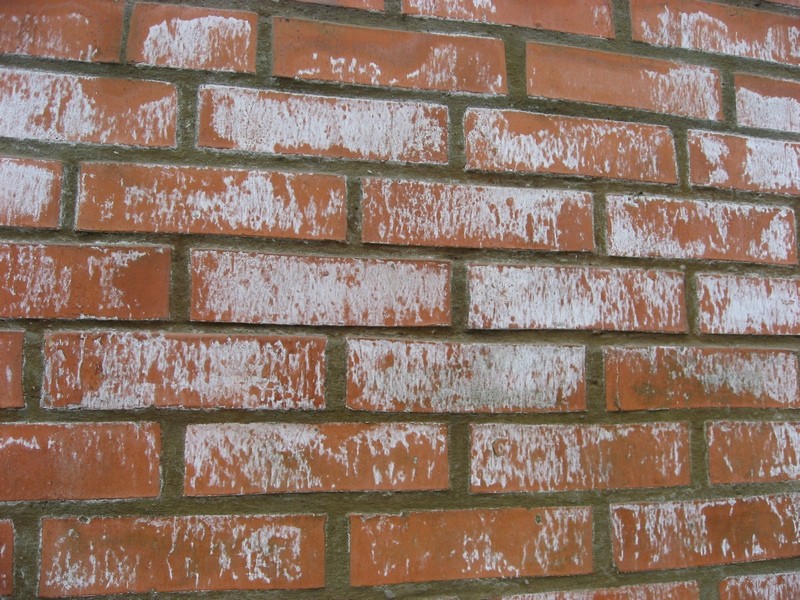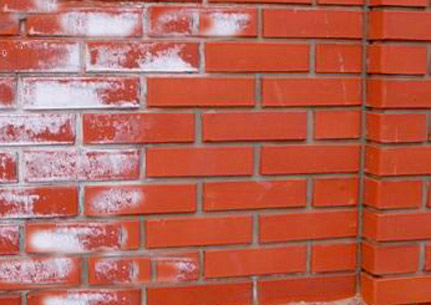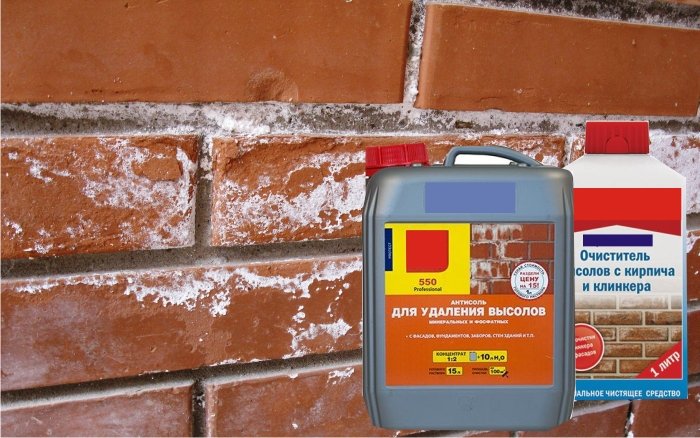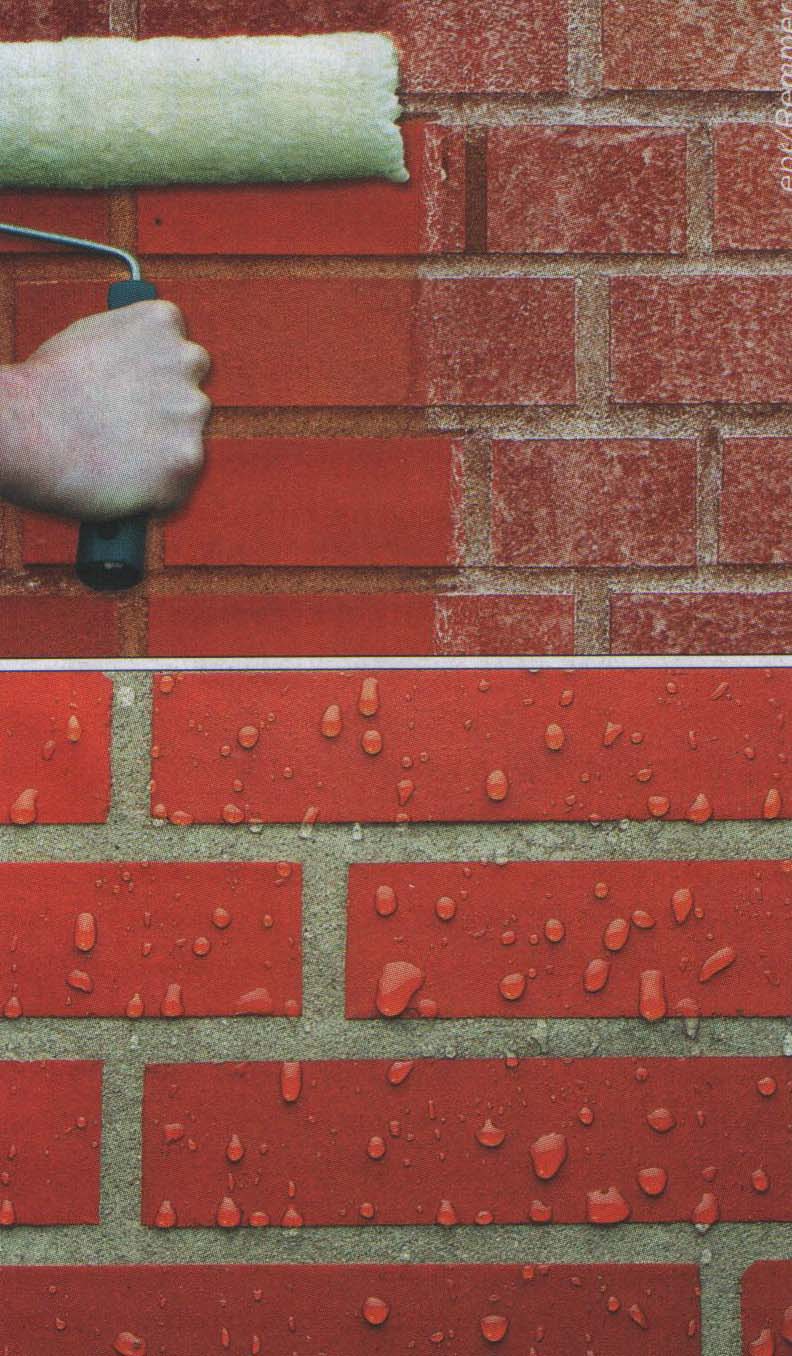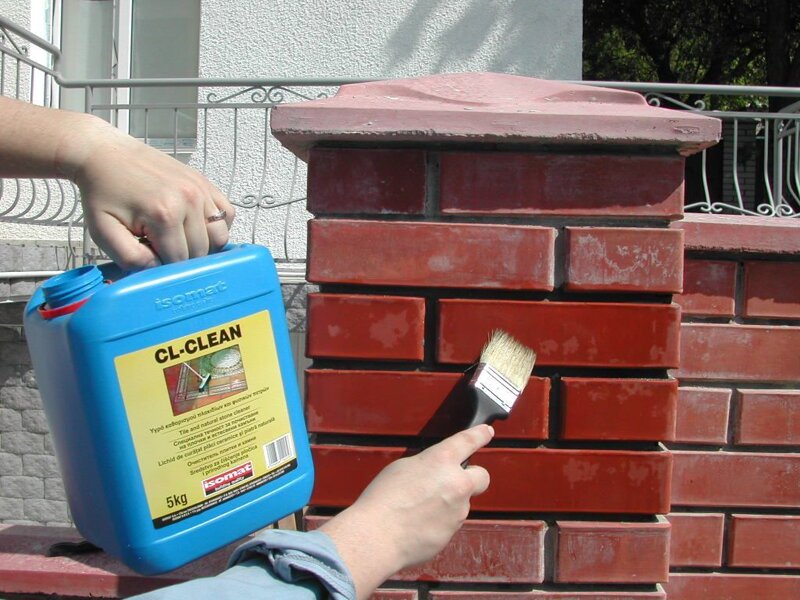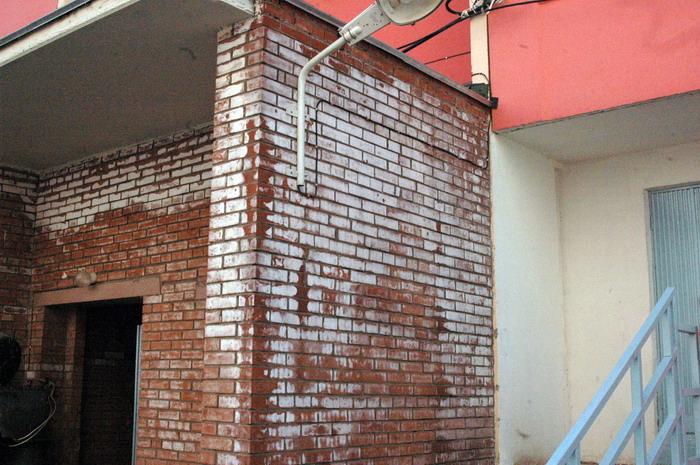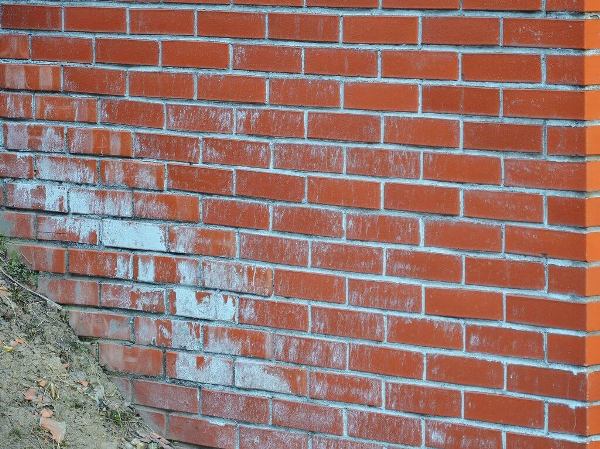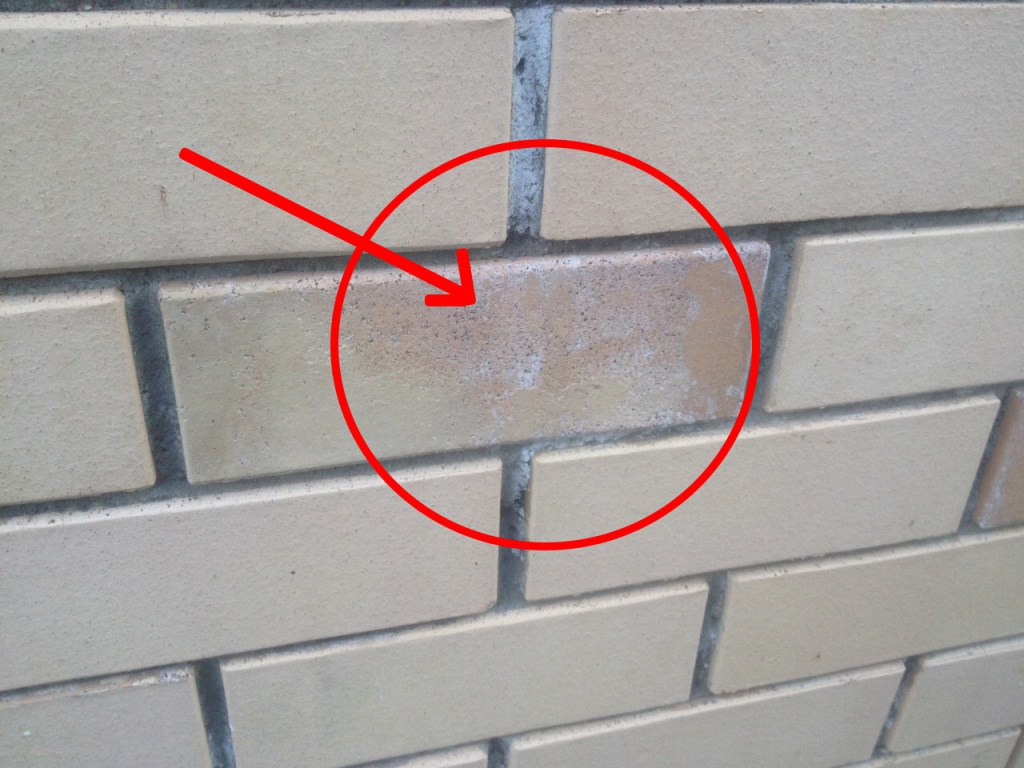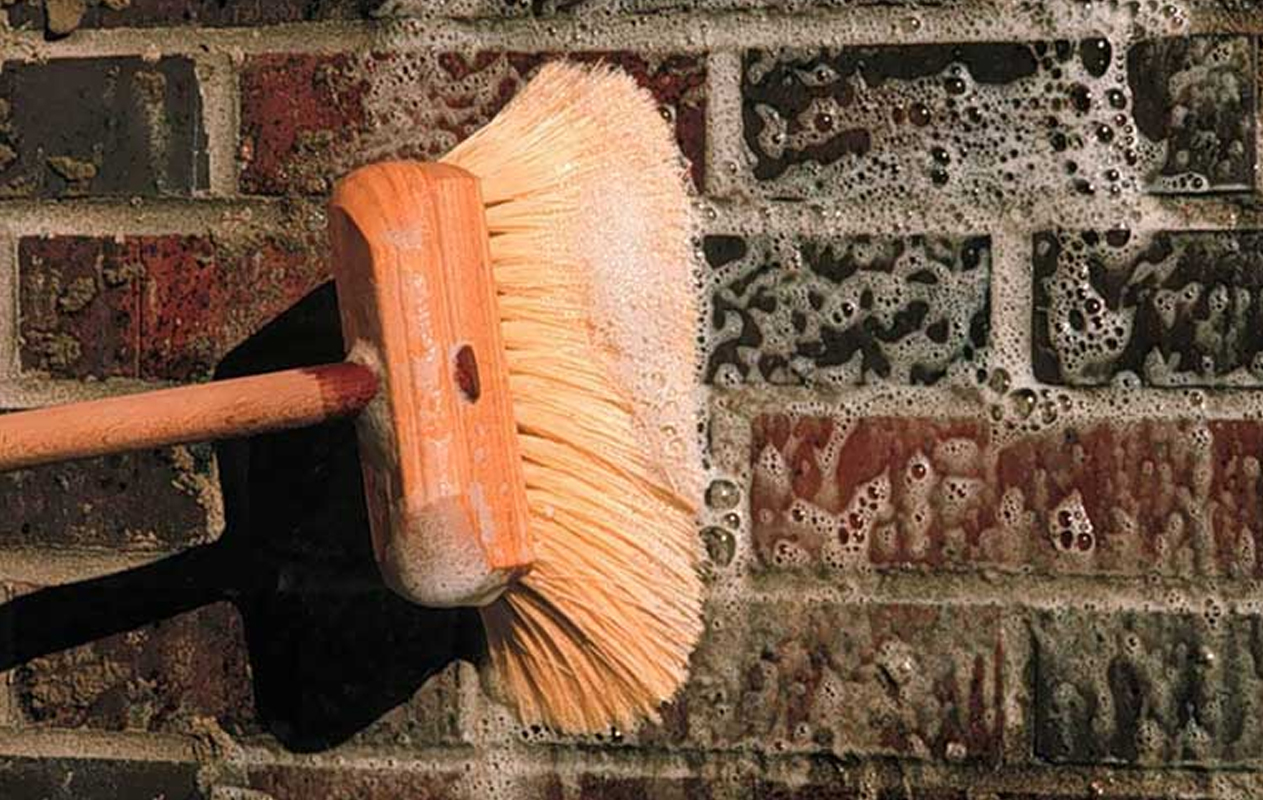Removal methods
If the spots began to appear, you need to immediately take measures to eliminate them, you should not postpone until later. There is a misconception that the salt layer just needs to be washed off with water. Surface treatment with water will cause the salts to dissolve and move inward. Such a wash will only aggravate the damage to the masonry. Cleaning bricks from efflorescence can be carried out mechanically or using chemical detergent mixtures.
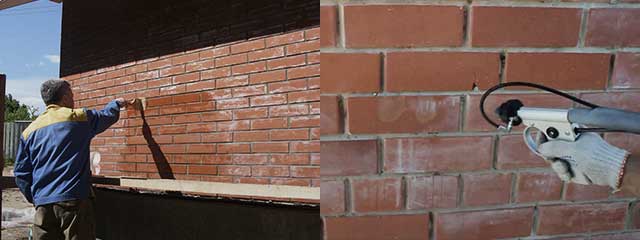
Mechanical cleaning
It takes a lot of physical strength to remove stains by mechanical means. The surface must be rubbed thoroughly with stiff brushes until all the white layer has been removed. With a small area of the damaged surface, it is possible to do this.
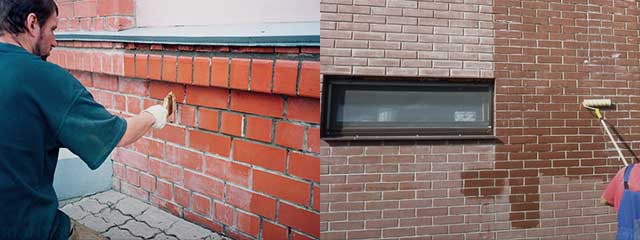
A great success is the presence of a sandblaster. The work must be carried out competently in compliance with safety rules. A stream of air with sand is injected onto the contaminated surface with the help of a compressor, under the action of which not only white streaks of salt are cleaned off, but also the remnants of the concrete mixture, stains of soot, paint, mold, moss. Work must be carried out with a mask and goggles to prevent airborne particles from entering the mucous membranes.
Detergents
Judging by the reviews, good results are provided by special cleaners presented in a diverse range. In most cases, universal formulations help to successfully cope with the problem.
First, the product must be diluted in water according to the instructions, then apply the solution to a small area of the masonry. After a few minutes, according to the recommendations, the composition can be washed off with water. Then the wall should be well dried and covered with a hydrophobic layer that penetrates a few centimeters deep, providing reliable protection for a long time.
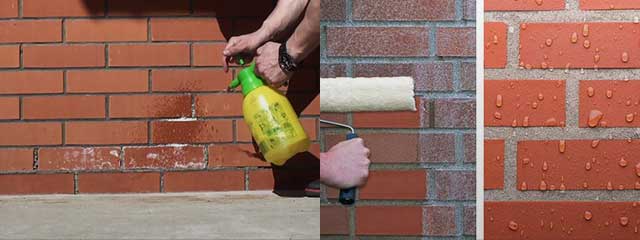
If you cannot buy special formulations, you can get by with homemade hydrochloric acid solutions with a concentration of 2% to 4%. With a large layer of salt stains, the mass fraction of acid in the solution should be increased to 6%. Work on cleaning brickwork with hydrochloric acid solutions must be carried out in a mask, since acid fumes are harmful to the body.
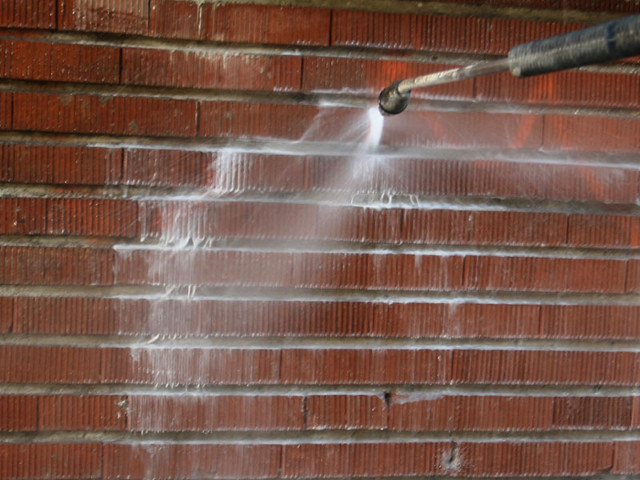
Some masters for the removal of efflorescence recommend treatment with a solution of copper sulfate, obtained by adding 1 part of the substance to 9 parts of water. For a number of reasons, the method is questionable. Copper salts can disinfect surfaces, but how they are supposed to dissolve deposits of other salts is not entirely clear. In addition, copper sulfate can stain the brick bluish or give it an odd tint.
Other craftsmen testify that a solution of ammonia helps to get rid of stains. The recommendation is also very dubious. Possibly, in certain geographic areas with a predominance of acidic salts, slightly alkaline solutions of ammonia worked. Everyone should not follow this advice.
p> Efflorescence on the walls is a long-known problem. The population with normally increased aesthetic requirements, who do not want to see dilapidated buildings, can use a variety of ways to prevent and eliminate defects.
1 Reasons for the formation of stains on brickwork
They appear on the surface in the form of deposits of a white or greenish tint due to the movement of salts out of the material. Salt inclusions can be present in brick, mortar for plasticizer and other additives that improve the performance of building materials. There is a small amount in snow, rain, tap and spring water.
In order for the salt coating to appear on the brickwork, the presence of water is necessary.Due to the porous structure of the brick, a lot of moisture accumulates in it. The salts present in the material dissolve in it. In dry weather, this mixture rises to the surface. The liquid evaporates, and the salt crystallizes and appears as a whitish coating. If there are chemical additives, then its color may be green.
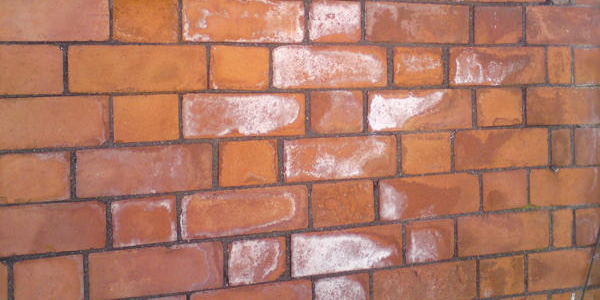
Crystallized salt is dangerous in that it has a destructive effect on bricks. It loses strength, crumbles, the wind contributes to weathering. The process takes place both on the surface and inside, which is more detrimental to the material. Due to the accumulated internal moisture, which has not found a way out, with temperature fluctuations, pores expand and cracks appear.
The concentration of salt inclusions in the brick depends on its quality. If it was manufactured without violating the technology, then salt inclusions should be absent. When using clinker bricks for masonry, which has increased resistance to moisture, the efflorescence that originally appeared on its surface will disappear over time.
To exclude salts in the masonry mortar, you need to prepare it correctly: do not add various kinds of additives. They may contain salt components that reduce the strength of the mortar, reduce adhesion to the brick, which, during operation, affects the water permeability of the walls. Do not use cement containing a lot of alkalis. The best option is Portland cement, which contains no additives. For exterior decoration, experts recommend using a cement-lime mortar.
Efflorescence on the brick may appear due to the sand that was taken to mix the solution. Depends on the place where it was mined. If these are regions with a saline environment, and the material has not been washed during use, this factor will manifest itself during operation. It is recommended to rinse the sand before use, this will get rid not only of salts, but also of foreign inclusions and various contaminants.
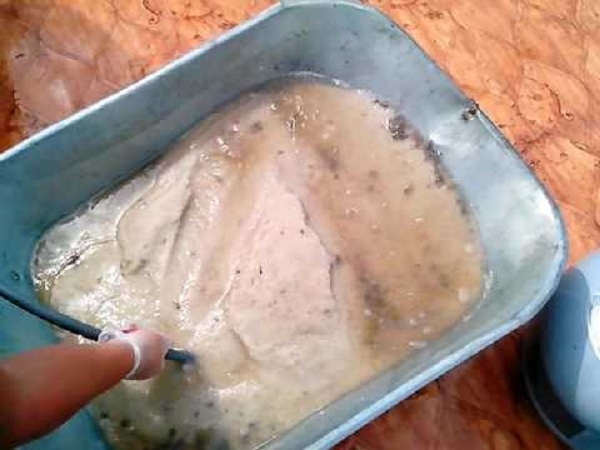
Particular attention should be paid to the condition of the brick if a heat insulator is installed between the cladding and the load-bearing wall. When the finishing layer is destroyed, the insulation becomes unusable, especially if the salt deposit has arisen due to poor-quality waterproofing
This leads to a decrease in thermal insulation performance.
Removing salts from masonry
For completeness, it should be noted that salt does not always appear on the masonry solely due to the absorption of atmospheric moisture. The additives added to the solution - anti-freeze, or accelerating the setting may be to blame here. The water used for mixing and the quality of the sand that must be washed is of great importance.
Capillary absorption of moisture occurs primarily due to the absence of layers of rolled waterproofing material between the base of the foundation and the basement wall, between the basement and the wall of the house. Moreover, this material should not be laid dry - it should be glued to the bituminous mastic.
Usually this is a whole complex of factors that lead to the same result. People who are engaged in construction with their own hands do not always know about such seemingly trifles, or they simply do not attach importance to them. And then they rack their brains: "How to remove efflorescence on a brick?" It is good that there are such means that allow you to fight this, frankly, unaesthetic phenomenon.
All means are good for the fight
Before discussing the process of cleaning masonry, let's figure out how to remove efflorescence on a brick. It is impossible to do this without a special tool.
Well, if you wash the facade, the salt deposits will appear over and over again - and this will continue until you do everything right. Let's see what the retail network offers us for this purpose.
- One of the most popular brands of efflorescence cleaning products is Neomid-550.This is a versatile option that can be used not only for brick, but also concrete and stone surfaces.
- The concentrated composition, before removing efflorescence on the brick, is diluted in half with water. If cleaning has to be done at subzero temperatures, alcohol can be used instead of water. It is packaged in bottles with a capacity of 1L, 3L and 5L, it costs about 400 rubles. per liter.
 How to remove efflorescence on facing brick: antisalt Neomid -550
How to remove efflorescence on facing brick: antisalt Neomid -550
- Equally effective and inexpensive is the Good Master brand. It penetrates deeply, dissolves and removes salt from the pores. Perfectly removes even old deposits. Packaged in cans of 5 liters and 10 liters, the cost is 450 and 860 rubles. respectively. It does not need to be diluted, since it is already ready for use. Unlike the previous version, it contains acid and removes all types of salts.
- Means "Antivysol Aqua", in general, is a universal cleaner. It is effective not only against soluble salts, but also against sulfate and carbonate deposits, therefore it can be used not only to remove efflorescence, but also to clean the facade from traces of masonry mortar.
The drug is also active against fungus and mold, which greatly simplifies the task, eliminating the need to buy a biocidal agent as well. With the exception of limestone and marble, it can be used on any surface.
The cleaner is ready for use, packaged in plastic containers of 5 liters and 10 liters, costs within 300 rubles. per liter.
Masonry processing process
There are a lot of tools designed to remove salts - we have presented only a small overview. As for the process of applying them, whichever option you choose, the processing is carried out in the same way.
First, the wall must be prepared by cleaning the exfoliating areas of the masonry from pieces and crumbs of brick, as well as brushing those places where there are significant deposits of salts with a metal brush. They need to be cleaned off so that only whitish spots remain.
 Cleaning brick walls
Cleaning brick walls
If the salt cleaner works effectively, the treated area becomes clean after a couple of minutes. Apply such compositions as a conventional primer - with a roller or brush. You can also use a spray bottle, but then the flow rate will be slightly higher than that declared by the manufacturer.
After withstanding the prescribed number of minutes after applying the drug, it should be rinsed with water from a hose with a good pressure. Then, the walls must be allowed to dry, and the protective silicone impregnation mentioned above can be applied.
Wall treatment order
Usually, there is no difficulty in using a cleaner. Before starting work, it must be diluted with water according to the manufacturer's instructions, then applied to problem areas of the wall (you can use a brush or roller), stand on the surface for 30 minutes and wash off with water, preferably under pressure.
Then we inspect the treated areas and determine which cleaner allows you to better remove plaque. We calculate the required amount to remove efflorescence on the entire affected surface. When working with the efflorescence cleaner, be sure to use protective goggles and rubber gloves, if the product comes into contact with unprotected skin, immediately rinse with clean water to avoid chemical burns.
To fix the result, it is necessary to treat the walls with a special impregnation (water repellent) in order to remove the basis for the re-formation of efflorescence. This should be done immediately, as soon as the cleaned brickwork is dry (or even better, as soon as the cement mortar of a freshly built house dries up, so as not to spend money and effort on combating efflorescence).
Hydrophobization of masonry

By covering the brick surface with a water repellent agent, you will protect it from corrosion, frost and fungus.
After it has been possible to remove salt stains with water or a cleaner, it is necessary to treat the surface with a special water-repellent impregnation - a water repellent. This impregnation will prevent the material from absorbing moisture, and without it, the appearance of salt stains will become impossible. Hydrophobization is a common way to protect building structures from moisture. Its difference from waterproofing is that hydrophobization maintains air permeability, and the material "breathes". In addition, hydrophobization increases:
- corrosion resistance by 1.5-2 times;
- frost resistance 3-5 times;
- gives antibacterial and antifungal properties.
And if you add a water repellent to a mortar for masonry, then it will increase both the strength and plasticity of the mortar (therefore, it is more convenient to lay a brick with such a mortar). The most reliable are organic silicon (silicone) water repellents. They are water-soluble, organic-soluble and aqueous. The most economical of them are water. There are water repellents that can be applied to a damp surface, there are water repellents, after which the surface can be painted.
It is necessary to apply the water repellent to the cleaned and dried surface with a brush, roller or spray. Water resistance increases within 5-11 days, even if it is raining and snowing outside. After drying, the surface acquires water-repellent properties, which persist for five or more years, depending on the climate and the quality of the water repellent and brick.
Prevention of efflorescence
Having cleaned the facade from the outside, after a while you can find fresh efflorescence on it, and then all the work must be done anew. Usually, a white bloom appears after frost during a thaw. Sometimes in the thickness of the brickwork, the salt content can amount to tens of kilograms. Until all this salt comes out, the plaque will reappear over and over again. But measures can be taken to restrain the leaching of salts and thus clog them in the wall for five years. To do this, create a protective barrier in the form of a hydrophobic impregnation, about 1 cm thick. This event is carried out in warm weather, at temperatures above 10 ° C. In a day, if efflorescence did not appear, re-hydrophobization is carried out.
An important property of water repellents for walls made of masonry materials is gas permeability. The best hydrophobizing compounds are silicone (organosilicon). They form a microscopic film on the walls of the capillaries, which prevents the passage of water molecules, but at the same time allows air molecules that are much smaller in size.
Hydrophobization, in addition to effective prevention of efflorescence, generally has a beneficial effect on the condition of the facade. It protects the material from weathering, improves the appearance of the facade, gives the walls a dirt-repellent effect, resists the formation of mold and even increases the thermal insulation properties of the enclosing structures.
Water repellents are applied with a roller or brush. The working solution finds pores by itself - just apply it to the walls
It is important to apply it on a dry surface. The hydrophobic properties of the wall appear after it is completely dry. One treatment lasts at least five years
Protective impregnations protect the walls from moisture, while the cracks become waterproof, up to 0.5 mm thick
One treatment is enough for at least five years. Protective impregnations protect the walls from moisture, while gaps up to 0.5 mm thick become waterproof.
Water repellents can have both liquid and pasty consistency. It is difficult to say which type is better, but the paste is applied more evenly, does not flow, which means it provides a high-quality hydro-barrier. Both types are produced on a water basis or on organic solvents. Water-soluble formulations are considered to be the most economical.However, their penetrating properties are somewhat worse than those of organosoluble hydrophobic impregnations. Although it is recommended to treat only dry surfaces with water-soluble impregnations, they can still be used to protect damp walls, for example, in a basement or cellar. Organosoluble water repellents can be applied exclusively to dry surfaces.
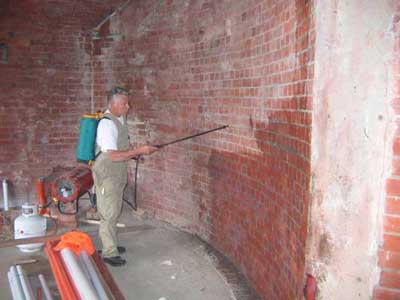 The degree and depth of impregnation is of great importance for materials with high water absorption. These include, first of all, silicate brick, therefore it is better to impregnate it with organic-soluble water repellents, which have a high penetrating ability.
The degree and depth of impregnation is of great importance for materials with high water absorption. These include, first of all, silicate brick, therefore it is better to impregnate it with organic-soluble water repellents, which have a high penetrating ability.
Among builders, one can often hear the opinion that silicone water repellents prevent further surface staining. However, this is only true for drugs of previous generations. Modern silicone compounds have good adhesion and can even be used as a facade primer.
Washers of efflorescence, primers and water repellents today can be purchased at any hardware store, both imported and domestically produced. We will not advertise specific brands here. But in fairness, I must say that domestic drugs are much cheaper, and in terms of quality they are practically not inferior to foreign counterparts.
List of sources
Reasons for the appearance of efflorescence on the wall of the house
On beautiful, red brick walls, every attentive owner will notice white stains right away, but not everyone will attach importance to this or will begin to act quickly to quickly eliminate the strange whitish pattern on the masonry. And this wavy pattern is efflorescence and it is worth removing them very quickly.
Efflorescence, in essence, is common salt that has emerged on the surface of a brick. Brick is a hard, porous sponge that perfectly absorbs moisture, and it, in turn, contains various salt impurities. At a certain temperature, there is a natural "evaporation" of salts on the surface of the brick, which, drying out, crystallize on the surface, forming sloppy stains. If it seems to you that the area of efflorescence is insignificant - do not flatter yourself and do not hope for chance. Only a small part of the entire salty "wealth" contained in the building material appears on the wall.
The appearance of efflorescence is a consequence of excess moisture. Salt deposits are found almost everywhere and their appearance on a brick surface is completely independent of a person.
The reasons themselves are quite commonplace and lie almost everywhere:
- The material from which the bricks are made contains a certain amount of salt. Due to the moisture easily absorbed by the brick, these chemical elements dissolve and are removed to the surface of the building material under the influence of high temperature in the process of liquid evaporation.
- The water that is added during the brick production process brings in its portion of the salt.
- Another prescription component in brick making that adds a fair amount of salt is sand, which contains a lot of lime. And, if it is not rinsed between cycles: mining in a quarry - adding to a brick batch, then the brick will obviously be pretty “salty”.
- The soil on which the house stands also tries not to lag behind anyone and makes its salty contribution to the appearance of the salt problem.
- Natural precipitation in any form - how can we go without it. And in cases where a chemical production or enterprise is located nearby, an increased portion of salt is provided to everyone.
- Lack of conservation of masonry in the autumn-winter period, if the building process is interrupted for any reason.
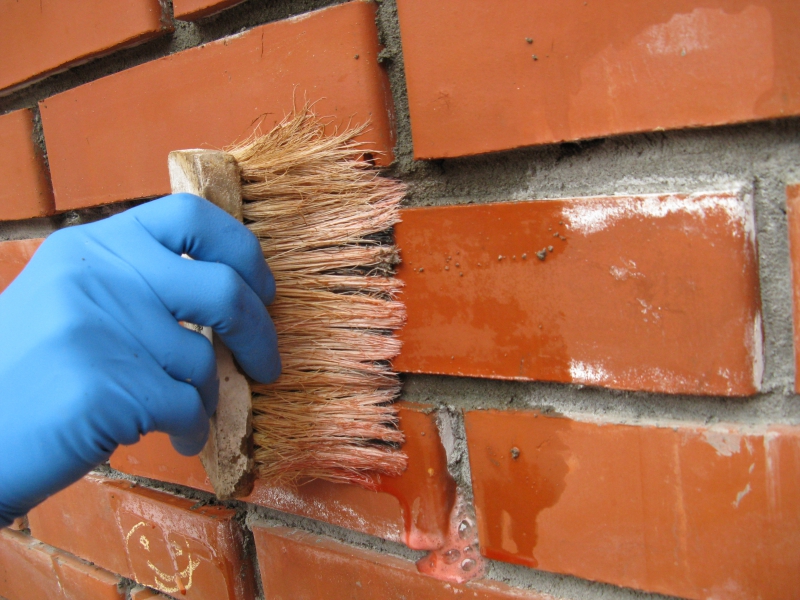
Do not take the appearance of efflorescence as a sentence to your building. As well as letting things go. Efflorescences are a kind of call for protective measures and preventive checks of roofs, cornices, drains, window sills, the integrity and reliability of waterproofing.If you correctly carry out all the work to eliminate efflorescence on the brick with your own hands or take preventive actions to prevent the appearance of efflorescence, then your head and conscience will be free for a long time from solving such a problem.
What are the cleaning methods?
Sometimes after construction work, brickwork must be cleaned of paint, plaster or concrete residues from it. There are several types of cleaning that allow you to wipe off dirt from the structure:
- mechanical - sand-lime brick cleaning;
- rinse with water;
- the use of special solutions.
To clean a brick wall from foreign material, you need to prepare in advance such tools as:
- metal scraper, brush, spatula, chisel;
- bucket;
- drill with replaceable nozzles;
- gauze mask or respirator;
- gloves.
From white bloom
Salts, which contain cement mortar, penetrate the surface of the brick, and provoke the appearance of a white coating on the masonry. It occurs after heavy rainfall. Such a phenomenon is dangerous in that it is capable of destroying the upper layer of materials: cracks and chips appear. You can wash the brick facade from this plaque with a special blasting - a highly concentrated substance that is diluted with water, observing a ratio of 1:10. After that, they act according to the following algorithm:
- The liquid is applied to the red brick with a brush.
- Leave for 20-30 minutes to absorb.
- Wash off with clean water. Such cleaning of brick walls from efflorescence is considered the most effective.
Cleaning bricks from grout
To wash off contaminated areas from facing bricks without difficulty, it is better to do this on the first day. Then, to remove, moisten the wall, and remove the residues with a spatula. Cleaning the façade in this way takes place quickly and without damage to the material. If the grout on the surface of the decorative brick has eaten, proceed according to the following scheme:
- A special blasting is selected and bred according to the instructions.
- Apply to the surface and leave for the required time.
- Remove residues with a spatula.
From plaster
A popular method of decorating masonry is plastering. However, this coating needs to be renewed over time, and old material must be completely removed prior to cleaning. You can properly clean your walls as follows:
- Remove all interior items from the room.
- Close doors and windows tightly to prevent dust from entering other areas.
- Remove the cement from the brick with a chisel and hammer.
- Wipe the surface from dust.
- Apply a special varnish.
After completing the work, it is necessary to wash the facing brick from dust residues. The cleaning procedure must be carried out in the direction from the upper corner. There is also a special cleaner to clean the wall from plaster, but it lasts longer and does not guarantee complete disposal of material residues. Decorative, volumetric plaster containing gypsum can also be laid on the surface of the masonry material.
From cement
After completion of construction work, it is necessary to clean the brick facade from the remains of the cement-sand mixture
To choose how to clean the masonry, you need to pay attention to the degree of contamination of the structure. It is better to clean the brick from the mortar in the first 24 hours after contamination.
There are two ways to clean a building:
- Mechanical option. Involves surface treatment with a metal brush or chisel.
- Chemical method. A brick cleaner is used, which contains hydrochloric or phosphoric acid. You cannot clean sand-lime brick like that.
From different types of paint
Very often, painting is chosen as a decor for brick walls. However, if you wish to lighten the silicate material for the purpose of further renewal, the coloring material must be removed. The method of soaking with vinegar was popular, but after the appearance of special solutions, it is practically not used.A sandblaster is often used, but it damages the masonry, which over time may require partial or complete disassembly of the structure. Therefore, it is better to work according to this scheme:
- Scrape off old material.
- Treat the surfaces with a special solution from the fungus.
- Apply cleaning solution.
- Remove paint residues. If the work is carried out indoors, it is better to stick paper on the walls and remove the material with it.
From clay in the form of a solution
Sometimes a brick is "set" on clay instead of cement. This prevents cracking of products during use. It is necessary to bleach the building material from the breed immediately. Until the solution has frozen, this can be done with a dry cloth made of natural fabric. However, if the breed has dried up, you need to act differently. Masonry on clay mortar is put in order by the same method as when cleaning a cement-sand mixture.
Prevention of efflorescence on brick
To prevent the appearance of efflorescence on the brick, our grandparents had many recipes in stock. For example, chicken eggs were added to the cement mortar that was prepared for the construction of a brick house. But modern people do not need to be cunning with inventions, especially since there are a lot of chemical and organic solutions that prevent the problem and reliably control salts with moisture.

For self-prophylaxis of efflorescence on a brick, any micro-foaming agents-water repellents based on naphthanic, rosin (resin) and fatty (ordinary vegetable oil) acids, as well as organosilicon compounds, are suitable for you. It is advisable, every few years, to process the brickwork of your walls with such solutions.
After completing construction and applying the protective agent, allow the walls to “rest” and dry. You should not start finishing work right away. If you've finished building your home in the summer, then the best time to dry your home is in the winter. Moreover, salt lime dissolves ideally at sub-zero temperatures.
During construction, in no case should the masonry be waterlogged. Therefore, it is better to suspend construction in the autumn-winter season, and to reliably preserve the already built-up areas.
It is believed that before starting construction, bricks should be soaked. So this is a huge delusion. This can not be done, as well as the liquefaction of the cement mortar.
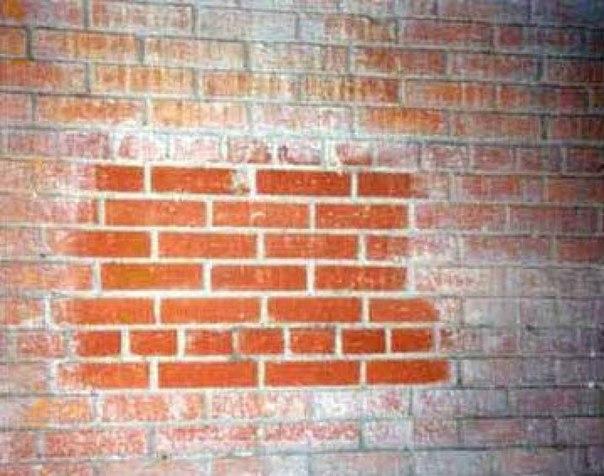
For convenience, we have put together preventive measures to prevent the appearance of brine on the brick:
Bricks should be purchased from a reliable and trusted manufacturer. It is impossible to visually determine the presence and amount of salts in a brick. Feedback from buyers and professionals to help you before buying.
The cement slurry should be thick enough and always fresh, and not yesterday's, diluted with water.
Use only coarse and well-washed mortar sand.
Do not use any additives in the grout. Even anti-freeze.
Work with masonry only in dry weather. The ideal season for construction is summer.
Preserve and cover the unfinished masonry from the weather, and it is better to drive the masonry under the roof as quickly as possible.
Handle the cement mortar carefully so as not to stain the walls of the house. And remove the entrained solution with a dry brush without hesitation
If the solution has time to dry - remove with a damp sponge - this is worse than in the first option, but it is extremely necessary to do the cleaning.
At the end of the work with the masonry and its complete drying, the facade is covered with a water-repellent or water-repellent composition.
It is very important to provide the building with a reliable and efficient drainage system, awnings and drains, so that even facades protected by mortars have minimal contact with water.



